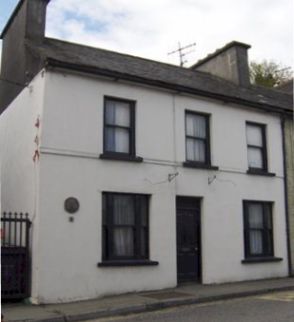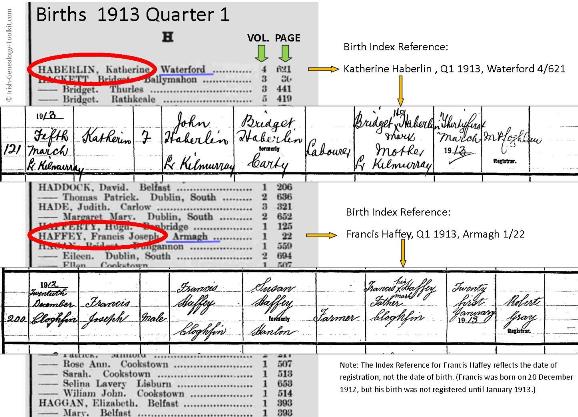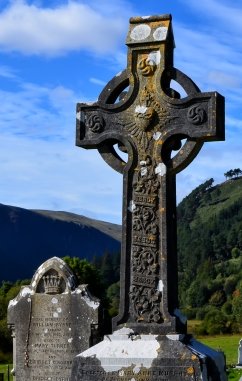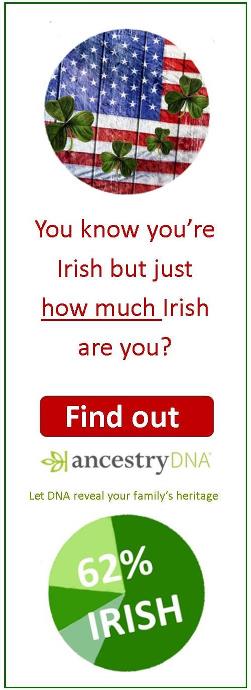- Home ›
- Civil Registration, Overview ›
- Indexes Part I
Using Irish Civil Registration
Indexes
Part 1
 The Old Dispensary in Skibbereen was typical of many local registration offices.
The Old Dispensary in Skibbereen was typical of many local registration offices.Until fairly recently, a manual search of the Irish civil registration INDEXES in either Dublin or Belfast was usually the starting point for most family historians.
These days, many of these searches are conducted via the Internet. However, online public access to Ireland's historical civil registration records is officially restricted to a 100-75-50-year cut-off in response to data protection concerns.
Civil Registration in Ireland
Births: From 1864
Marriages: From 1845/1864
Deaths: From 1864
While there are indexes online that do not apply this cut-off, none of them extends past 1921/1958 (NI/ROI).
This page explains when and how civil birth, marriage and death records were collected and collated, and how to find them in the indexes. This information could help you if you run into difficulties finding the individual records you are seeking.
Brief history and organisation of Ireland's civil registration system
The Irish civil registration system was introduced in April 1845 but was initially restricted to non-Catholic marriages. Births, deaths and Catholic marriages were not included at this time.
Only in January 1864 did it become obligatory to register ALL births, ALL marriages and ALL deaths with the local authorities.
To comply with the legislation or risk a fine, citizens made a trip to the local register office to record a birth or death; church or civil officials who conducted weddings were responsible for sending details of marriages to the local register office.
Civil Registration in Ireland
- Births: From 1864
- Marriages: From 1845/1864
- Deaths: From 1864
Although the indexes are compiled from the data entered into the registers of births, marriages and deaths, they do not contain all the information supplied at the time of registration. They are, after all, indexes, not full-blown transcriptions of the register entries.
Local register offices were organised into Superintendent Registrar Districts (SRDs), who had to create copies of their registers and send them to the General Register Office (GRO) in Dublin. Indexes were then compiled in Dublin either quarterly or annually (depending on the year) on receipt of registers from all the Superintendent Registrar Districts (SRDs) across Ireland.
From 1922, details of births, marriages and deaths that took place in SRDs in the six counties of Northern Ireland were sent to the General Register Office of Northern Ireland (GRONI) for indexing, while registers for the remaining 26 counties continued to be sent to GRO Dublin (until 2005 when the GRO moved to Roscommon).
Although the indices are compiled from the data entered into the registers of births, marriages and deaths, they do not contain all the information supplied at the time of registration. They are, after all, indexes, not full-blown transcriptions of the register entries.
Although the indexes are compiled from the data entered into the registers of births, marriages and deaths, they do not contain all the information supplied at the time of registration. They are, after all, indexes, not full-blown transcriptions of the register entries.
Arrangement of the Irish civil registration indexes
Separate indexes were created for Births, Marriages and Deaths. At the GRO Research Room in Dublin, the Births Indexes are bound in Red covers, the Marriages in Green, and the Deaths in Black.
From 1845-1863, the marriage indexes (which include only non-Catholic marriages) are arranged alphabetically and are hand-written. After this date, the indexes are typed.
From 1864 to 1877, each annual index is in alphabetical order (no quarters were used).
 Irish civil registration indexes up to current years are on the shelves of the GRO Research Room in Dublin. They can be manually searched for a fee.
Irish civil registration indexes up to current years are on the shelves of the GRO Research Room in Dublin. They can be manually searched for a fee.From 1878, the indexes are arranged alphabetically by quarter (ie four quarters to one annual volume). Unless you are certain of the date of the event, when searching the indexes manually you need to check all four quarters and bear in mind that a birth, marriage or death that occured in one quarter may not have been registered until the following quarter.
From 1903, the birth indexes (but not the marriage or death indexes, which are presented in quarters) are in alphabetical order in one book per year. The maiden name of the baby's mother is recorded, too, for the first time. This makes searching for a large family of children much easier.
From 1922, following the division of the island into Northern Ireland and the Republic of Ireland, the GRO function was split between GRO Dublin and GRONI Belfast.
Late, overseas and military registrations
Each volume of the Irish civil registration indexes has a section at the back where late registrations were entered. These entries may have been registered only just outside the six-week registration limit or they may have been several years late.
From 1879 there are also separate pages for the registrations of overseas births and deaths for Irish soldiers and Irish civil servants.
Late, overseas and military registrations
Each volume of the Irish civil registration indexes has a section at the back where late registrations were entered. These entries may have been registered only just outside the six-week registration limit or they may have been several years late.
From 1879 there are also separate pages for the registrations of overseas births and deaths for Irish soldiers and Irish civil servants.
Irish civil registration indexes - creating the Index reference
If you are searching the Irish civil registration indexes online at IrishGenealogy.ie,
you will find most index entries have a Group Registration ID; this
'GRID' no + surname (ie 2636887 Santry), is a 'new-style' Index
reference number used by the General Register Office in the Republic of
Ireland. If it's provided, note it.
In all other cases, whether you're searching the manual books or one of the online databases, you will find each entry in the manual and online indexes contains the following:
- Surname
- Christian name
- name of Superintendent Registration District in which the birth, marriage or death took place
- Volume number and page number of the register in which the entry was recorded.
To these details you add the year (and quarter, if relevant) to create the old-style Index reference. See the image below to get a clearer idea of this. (Click the image for an enlarged view).
By quoting the correct reference, you can obtain a copy of the register entry, containing all the additional registration details. See Step 4 on the main Civil Registration page.
Related pages
► Irish civil registration records – an overview
► Northern Ireland bmds► Local registration districts
► Ireland's birth records
► Irish marriage records




